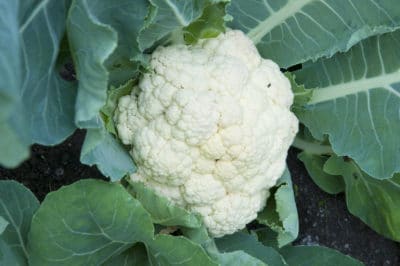How to Plant Cauliflower
Cauliflower is planted in the spring and the fall. For a head start on the season, plant seeds indoors or in a greenhouse four to seven weeks before the last frost in your region. Acclimate them by bringing them outdoors for increasing increments of time over a couple of weeks.
Fall cauliflowers mature faster than spring cauliflowers. Plan for a five to seven week crop cycle for the fall, and a 10-week crop cycle for spring plants. Cauliflower can take a frost, but a hard freeze will damage plants.
Cauliflower Planting Guide:
- Spring Planting – Direct seed 2-3 weeks before last frost.
- Fall Planting – Direct Seed 6-8 weeks before first frost.
- Successional Planting – For continuous harvet, plant seeds every two weeks from spring to fall, shade summer crops to avoid bolt.
Cauliflower is a heavy nutrient user. It prefers very rich and neutral soil, so amend planting beds with finished compost or worm castings before planting seeds or seedlings. A 2-3 inch top dressing of compost will work. If you are digging or tilling the soil you can work the compost into it.
Space plants about 18 inches apart, and rows about 30 inches apart for access. When planting from seed, plant seeds 1/2 inch deep with 1-2 inch spacings for easy thinning.
How To Care For Cauliflower
Keep the ground moist by checking it and watering regularly. Use mulch to trap moisture and keep the roots of your cauliflower cool.
Cauliflower is blanched in order to keep the head white and delicate. Most plants will ‘self-blanch’ and so do not require any work. Others, though, will need your help. Blanching simply means shaded, and small growing cauliflower heads will shade themselves with their own leaves.
If there are two little leaves growing together over the developing head that plant is self-blanching. If that is not the case simply take two leaves and tie them together over the head with some twine.
How to Harvest Cauliflower
A mature cauliflower head is compact, pure in color, and about 6 inches in diameter. Some larger heads can reach up to 12 inches in diameter so pay attention to the variety used and watch the plant for signs of over-maturity. If the head begins to separate or become discolored, these are signs of over-maturity and it should be harvested.
To harvest a cauliflower head, just take a knife or pair of sharp pruning shears and slice the head off as low to the ground as you can. Typically you will get a bunch of leaves with your head that you can break off, leaving just a few to protect it and keep it clean. Cauliflower greens are great to saute, steam, juice or feed to animals.
Common Problems and Solutions
Extreme cold or heat will damage cauliflower plants. Using shade cloth and freeze barrier to protect your plants from any extreme temperatures will produce a healthier crop.
Nutrient deficiencies effect cauliflower development. If leaves begin to brown everywhere but the veins and older leaves prematurely wilt and fall off, this is a sign of magnesium deficiency. This actually points to the soil being too acidic and in this case, amending with lime or something to raise your soil ph is the best course. Hollow stems in a plant point to an excess of nitrogen which is only likely to happen if using a fertilizer. In this instance, water the plant with diluted seaweed to add boron.
Pests of all kinds love cauliflower florets. Encouraging diversity in the garden is always your best defense against critters. Invite ladybugs and praying mantis to keep aphid populations in check. Plants aromatic herbs to attract parasitic wasps which prey on caterpillars. Build snake habitat and invite them to come into the garden and dine on your slug population.
Companion Planting
Companion planting is a method of planting two or more species together in the same bed that mutually benefit each other. onions repel pests like slugs and caterpillars, and they use more water leaving nutrients in the soil for your plant.
Beans are nitrogen fixing. Instead of using nitrogen that the cauliflower needs, beans will actually pull nitrogen from the air and fix it into the soil. Celery attracts beneficial insects and it doesn’t require a whole lot of nutrients. Plant your polyculture beds and reap the benefits today.
